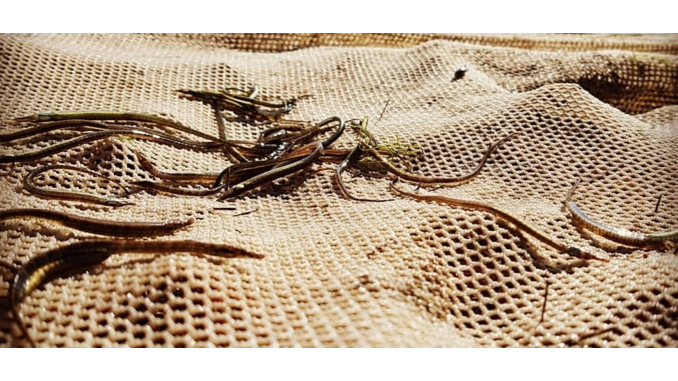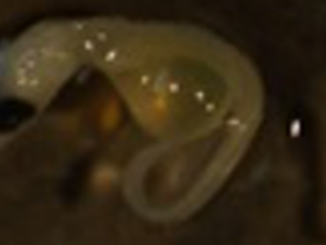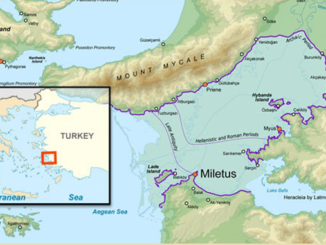
Paper category: Original research paper
Corresponding author: Sule Gurkan (sule.gurkan@ege.edu.tr)
DOI: 10.2478/oandhs-2021-0003
Received: 20/07/2020
Accepted: 31/08/2020
Full text: here
Citation (APA style): Gurkan, S., Innal, D. & Gulle, I. (2021). Monitoring of the trophic ecology of pipefish species (Syngnathus abaster, Syngnathus acus) in an alluvial lake habitat (Lake Bafa, Turkey). Oceanological and Hydrobiological Studies, 50(1), 24-32. https://doi.org/10.2478/oandhs-2021-0003
Abstract
The present study investigated the trophic ecology of two species living in an alluvial lake ecosystem in terms of season, length groups, sex, and mouth morphology. The fish were caught in a coastal lake area between December 2014 and March 2016 using a seine. In general, C. aquaedulcis was the most important prey for S. abaster, accounting for 10.99% of all prey, while amphipods accounted for 54.04% of the S. acus diet. Amphipods were the most frequently consumed prey in autumn, while C. aquaedulcis was the most important prey in spring. This result indicates that the species preferred similar prey groups and generated food competition depending on the season. The short-length group contained samples of S. abaster with empty guts, whereas S. acus in the same group consumed C. aquaedulcis. Length group II and III of individuals indicated that both species consumed amphipods and juvenile Syngnathus sp. Thus, the two species had statistically different preferences in terms of prey length. The mouth width of S. abaster was larger than that of S. acus. In conclusion, zooplankton constituted the main prey for both species in the lake and the morphological differences between the mouth apparatus of the species were due to the differences in feeding habits.
Conclusion
The results of the study showed that zooplankton was the main prey group in the alluvial lake environment, and the differences in feeding habits of the two species were attributable to the differences in their mouth apparatus. However, the effect of pipefish on the food ecology of the lake was not significant. On the other hand, maintaining the existing aquatic vegetation in the lake will help in the survival of the fish species and allow more detailed studies.
References
Bagenal, T.B. & Tesch, F.W. (1978). Age and Growth. In T. Bagenal (Ed.), Methods for Assessment of Fish Production in Fresh Waters, 3rd Edition, IBP Handbook No. 3 (pp. 101–136). Blackwell Science Publications, Oxford.
Balık, S. & Ustaoglu, M.R. (1989). Bioecological and Economic Examination of Ulubat Fish (Acanthobrama mirabilis Ladiges, 1960) in Bafa Lake. Turk. J. Zool, 13(3): 141–174.
Cakić, P.M., Lenhardt, D., Mićkovıć, N., Sekulıć, L. & Budakov, J. (2002). Biometric Analysis of Syngnathus abaster populations. J. Fish Biol. 60: 1562–1569. DOI: 10.1016/j.jglr.2015.07.004.
Campolmi, M.P., Franzoi, P. & Mazzola, A. (1996). Observations on pipefish (Syngnathidae) biology in the Stagnone lagoon (west Sicily). Publicaciones especiales del IEO, 21: 205–209.
Dawson, C.E. (1986). Syngnathidae. In P.J.P. Whitehead, M.-l. Bauchot, J.-C Hureau, J. Nielsen & E. Tortonese (Eds.), Fishes of the north-eastern Atlantic and the Mediterranean. Vol. 2 (pp. 628–639). Unesco, Paris.
De Lussanet, M.H.E. & Muller, M. (2007). The smaller your mouth, the longer your snout: predicting the snout length of Syngnathus acus, Centriscus scutatus and other pipette feeders. JR Soc Interface 4(14): 561–573. DOI: 10.1098/rsif.2006.0201.
Didenko, A., Kruzhylina, S. & Gurbyk, A. (2018). Feeding patterns of the black-striped pipefish Syngnathus abaster in an invaded freshwater habitat. Environ. Biol. Fishes 101: 917–931. DOI: 10.1007/s10641-018-0747-x.
Franzoi, P.R., Maccagnani, R.R. & Ceccherelli, V.U. (1993). Life cycles and feeding habits of Syngnathus taenionotus and Syngnathus abaster (Pisces, Syngnathidae) in brackish bay of the Po River delta (Adriatic Sea). Mar. Ecol. Prog. Ser. 97: 71–81.
Gurkan, S. & Innal, D. (2018). Some morphometric features of congeneric pipefish species (Syngnathus abaster Risso 1826, Syngnathus acus Linnaeus, 1758) distributed in Lake Bafa (Turkey). Oceanol Hydrobiol. Stud. 47(3): 239–247. DOI: 10.1515/ohs-2018-0023.
Gürkan, S. & Uncumusaoglu, A.A. (2012). Food compositions of some Syngnathid species (Syngnathus sp., Nerophis sp., Hippocampus sp.) from coastal waters of Sinop peninsula (southern Black Sea). BSJ Eng. Sci. 2(7): 29–38.
Howard, R.K. & Koehn, D.J. (1985). Population dynamics and feeding ecology of pipefish (Syngnathidae) associated with eelgrass beds of Western Port, Victoria. Mar. Freshwater Res. 36: 361–370. DOI: 10.1071/MF9850361.
Kasparek, M. (1988). Bafasee. Natur und Geschichte in der Türkischen Ägäis – Heidelberg (p. 174).
Kendrick, A.J. & Hyndes, G.A. (2005). Variations in the dietary compositions of morphologically diverse Syngnathid fishes. Environ. Biol. Fishes 72: 415–427.
Kuiter, R. (2000). Seahorses, pipefish and their relatives: a comprehensive guide to Syngnathiformes (Marine Fish Families S.) TMC Publishing.
Kuru, M., Balık, S., Ustaoğlu, M.R., Ünlü, E., Taşkavak, E. et al. (2001). Evaluation Criteria of fish found by the Ramsar Convention on Wetlands in Turkey. Project Report, (pp.55–58).
Liao, H., Pierce, C.L. & Larscheid, J.G. (2001). Empirical assessment of indices of prey importance in the diets of predacious fish. T. Am. Fish. Soc. 130: 583–591. DOI:10.1577/1548-8659(2001)130%3C0583:EAOIOP%3E2.0.CO;2.
Lyons, D.O. & Dunne, J.J. (2004). Inter- and intra-gender analyses of feeding ecology of the worm pipefish (Nerophis lumbriciformis). J. Mar. Bıol. Assoc. UK 84: 461–464. DOI: 10.1017/S0025315404009452h.
Moreira, F., Assis, C.A., Almeida, P.R., Costa, J.L. & Costa, M.J. (1992). Trophic relationships in the community of the Upper Tagus Estuary (Portugal: a preliminary approach. Estuar Coast Shelf S. 34: 617–623. DOI: 10.1016/S0272-7714(05)80066-6.
Oliviera, F., Erzini, K. & Goncalves, J.S. (2007). Feeding habits of the deep-snouted pipe-fish Syngnathus typhle in a temperate coastal lagoon. Estuar. Coast. Shelf. S. 72: 337–347 DOI: 10.1016/j.ecss.2006.11.003.
Pollom, R. (2016). Syngnathus abaster. The IUCN Red List of Threatened Species. e.T21257A19423178. DOI: 10.2305/Iucn.Uk.2016-3. RLTS.T21257A19423178.en.
Ryer, C.H. & Orth, R.J. (1987). Feeding Ecology of the Northern Pipefish, Syngnathus fuscus, in a Seagrass Community of the Lower Chesapeake Bay. Estuaries 10(4): 330–336. DOI: 10.2307/1351891.
Sarı, H.M., Balık, S., Bilecenoğlu, M. & Türe, G. (1999). Recent changes in the fish fauna of Lake Bafa, Aegean region of Turkey. Zool. Mıddle East. 18(1): 67–76. DOI: 10.1080/09397140.1999.10637783.
Smith-Vaniz, W.F. (2015). Syngnathus acus. The IUCN Red List Of Threatened Species. e.T198765A44933898. DOI: 10.2305/ıucn.uk.20154. RLTS.t198765a44933898.en. Feb.2020.
Sokal, R.R. & Rohlf, F.J. (1969). Biometry. W.H.Freeman and Company, San Fransisco. (p. 776).
Stefee, A.S., Westoby, M. & Bell, J.D. (1989). Habitat selection and diet in the two species of pipefish from seagrass: sex differences. Mar. Ecol. Prog. Ser. 55: 23–30.
Tasdemir, A. & Ustaoglu, M.R. (2005). Taxonomical investıgation of Lake District Inland Waters Chironomidae and Chaoboridae (Diptera) fauna. Ege JFAS 22(3): 377–384.
Taskavak, E., Gurkan, S., Sever, T.M., Akalın, S. & Ozaydın O. (2010). Gut contents and feeding habits of the Great Pipefish, Syngnathus acus Linnaeus, 1758, in Izmir Bay (Aegean Sea, Turkey) (Osteichthyes: Syngnathidae). Zool. Mıddle East. 50: 75–82. DOI: 10.1080/09397140.2010.10638414.
Teixeira, R.L. & Musick, A. (1995). Reproduction and food habits of the lined seahorse, Hippocampus erectus (Teleostei: Syngnathidae) of Chesapeake Bay, Virginia. Braz. J. Med. Biol. Res. 61(1): 79–90. DOI: 10.1007/BF00005862.
Tesh, F.W. (1971). Age and growth. In W.E. Ricke (Ed.), Methods for assessment of fish production in fresh waters. Oxford: The Blackwell Science. (pp. 98–130).
Tipton, K. & Bell, S.S. (1988). Foraging patterns of two syngnathid fishes: importance of the harpacticoid copepods. Mar. Ecol. Prog. Ser. 47: 31–43.
Tuna, M. (2015). Biodiversity and Environmental Problems of Lake Bafa. In H. Şaşı & M. Yabanlı (Ed.), Determination of Community Supported Ecotourism Activities in Bafa Lake Basin. Project Report, GEKA. (pp. 96–132). TR32-14/DFD/0043 Muğla Sıtkı Koçman University.
Turgutcan, B. (1957). Lake Bafa. Balık ve Balıkçılık 5(11): 19–22.
Vizzini, S. & Mazzola, A. (2004). Stable isotope evidence for the environmental impact of a land-based fish farm in the western Mediterranean. Mar. Pollut. Bull. 49: 61–70. DOI: 10.1016/j.marpolbul.2004.01.008.


